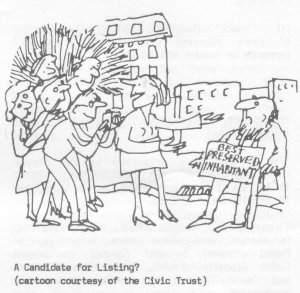Listing of Historic Buildings - TrustNews Spring 1988
An interesting Seminar was held at King Alfred's College on 27th February under the auspices of the Hampshire Field Club, where all aspects of the Listing of Buildings of Special Architectural or Historic Interest were discussed.
As a general rule, all buildings built before 1700 which survive in anything like their original condition qualify for Listing, as do most buildings of 1700 to 1840. 3etween 1840 and 1914 only buildings of finite quality and character qualify and the selection is designed to include the principal works of the major architects. Selected buildings constructed after 1914 are also considered.
These Listings are dealt with by the Department of the Environment and there is a separate Schedule of Ancient Monuments which, broadly speaking, relates to uninhabited historic buildings. It was brought out at the Seminar, however, that there is some overlap.
The DoE has no plans at present to update the Winchester List (compiled in 1974) because financial resources are being directed to parts of the country which have not yet been surveyed. Furthermore, there is now a two-year nationwide delay in dealing with proposed additions to the Schedule of Ancient Monuments. Fortunately, however, the DoE is prepared to consider applications for Spot-listing.
The Trust is currently co-operating with the Winchester City Conservation Officer in the submission of proposals for Spot-listing - a recent success being the Listing of the White Swan in Hyde Street, which dates from the 17th century. We are also anxious that consideration should be given to "The Pagoda" in St. James Lane, the Rising Sun in Bridge Street and our own Heritage Centre.

A candidate for Listing?
(cartoon courtesy of the Civic Trust)
Another structure in which the Trust is particularly interested is the mediaeval bridge beyond the site of the North Gate. This was mentioned at the Seminar, and although protection is now urgent, (as talks are being held about the redevelopment of the Brewery site) no solution was put forward. Undoubtedly, this bridge, which carried the road over the City moat, should be Scheduled as an Ancient Monument as there can be very few such bridges still in existence. The loss of the adjacent Roman vallum would also be a disaster. In neither case does Listing seem to be appropriate, but with the current backlog in Scheduling, it appears to be the only answer.
The writer will be glad to receive suggestions for Spot-listing (Tel.Winchester 54552). In choosing buildings the DoE pays particular attention to the following:
- Special value within certain types, either for architectural or planning reasons or as illustrating social and economic history (for instance, industrial buildings, railway stations, schools, hospitals, theatres, town halls, markets, exchanges, almshouses, prisons, lock-ups, mills).
- Technological innovation or virtuosity (for instance cast iron, prefabrication, or the early use of concrete).
- Association with well-known characters or events.
- Group value, especially as examples of town planning (for instance, squares, terraces or model villages).
